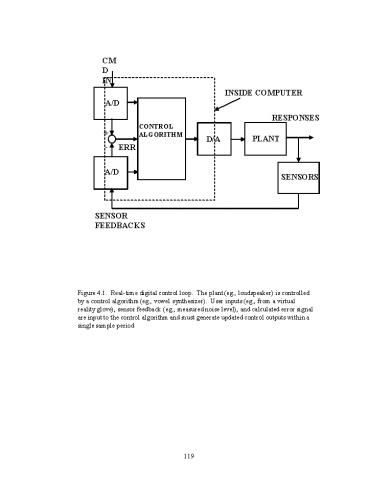PLANT PowerPoint PPT Presentation
Title: PLANT
1
CMD IN
INSIDE COMPUTER
A/D
RESPONSES
CONTROL ALGORITHM
PLANT
D/A
-
ERR
A/D
SENSORS
SENSOR FEEDBACKS
Figure 4.1. Real-time digital control loop. The
plant (eg., loudspeaker) is controlled by a
control algorithm (eg., vowel synthesizer). User
inputs (eg., from a virtual reality glove),
sensor feedback (eg., measured noise level), and
calculated error signal are input to the control
algorithm and must generate updated control
outputs within a single sample period
2
COMPUTATION CYCLE
CLOCK0
CLOCK1
CLOCK
TIME
ALGORITHM (1 CLOCK)
A/D
D/A
SENSOR
PLANT
Figure 4.2. Real-time control timing. For
real-time digital control, the entire computation
cycle must be completed in one sample period.
The A/Ds provide comand and sensor inputs to the
CPU on clock0. The CPU performs control
calculations between clock0 and clock1. New D/A
values are output to the plant on clock1.
3
Figure 4.3. X86 processor performance
progression. The numerical processing speed of
the PC CPUs increased dramatically over the
progression from 8086 to 80586 (Pentium) as both
clock speed and processor efficiency improved.
Column 2 is CPU clock speed, column 3 is number
of clocks to perform a multiplication in the
formant resonator calculation process (16 bit
fixed point for the 8086 80286, and 64 bit
floating for the rest). Column 4 is the time in
microseconds to perform the multiply. Column 5
is the time to perform all the calculations for
ten formant resonators. Column 5 is the
percentage of a 10 kHz cycle budget (0.1 ms)
consumed by calculations for 10 resonators. It
is noteworthy that the transition from 16 bit
integer to 64 bit floating actually resulted in
less CPU time.
4
ALPHA REAL-TIME SYNTHESIZER FUNCTIONAL OVERVIEW
5 RESONATORS
R2
R3
R4
LOW PASS FILT.
R1
R5
D/A
AMP
SPKR
IMPULSE SOURCE
HARDWARE INTERRUPT TO X86 PROCESSOR
CTM05 PROGRAMMABLE CLOCK
Figure 4.4. Overview of the alpha real-time
vowel synthesizer. This first implementation
used commercially available adapter cards and
prototyping circuitry external to the PC
platform. It used a simple impulsive source to
excite a bank of 5 second order digital
resonators implemented in 16 bit scaled integer
arithmetic and programmed in X86 assembly
language.
5
CURRENT REAL-TIME SYNTHESIZER FUNCTIONAL OVERVIEW
X86 INTERRUPT
IMPL
CLK
SOURCE SELECTION
20 POLES
4 ZEROS
KGLOT 88
LOW PASS FILT.
. . .
D/A
AGC
LF1
RECORD WAV
AMP
GAH
LF2
OUTPUT SIGNAL FILE
STORE/RECALL CONTROL PARMS
ASP NOISE
SPKR
ARB
SOURCE CONTROLS
ARBITRARY SOURCE FILE
PARAMETER TIME VARIATION
JITTER
SHIMMER
DIPLOPHONIA
Figure 4.5. Overview of the current real-time
synthesizer. Upgrades include flexible source
specification (impulse, KGLOTT88, LF, or
arbitrary waveform), an aspiration noise source,
vocal tract transfer function numerator zeros, an
automatic gain control, jitter, shimmer,
diplophonia, arbitrary time variation of
parameters, and the ability to store and recall
time series and parameter sets. All hardware
components are grouped on one adapter card.
6
REAL-TIME SYNTHESIZER HARDWARE
CB
ADDRESS BUS
ADDRESS DECODE
CLOCK GENERATOR
AB
DB
CB
ISA BUS
TIMING CONTROL
CB
DATA BUS
DB
ANALOG OUTPUT
CONTROL BUS
CB
CB
DB
DB
CONTROL REGISTER
D/A LATCH
D/A CONVERTER
Figure 4.6. Real-time synthesizer hardware.
Several hardware features were required to
achieve true real-time performance on the PC
platform. These include a crystal-controlled
clock, a D/A converter, data latches, and timing
and control glue logic to interface these
components.
7
REAL-TIME SYNTHESIZER SOFTWARE
INITIALIZATION/ SHUTDOWN
INTERRUPT SERVICE
START
START
PERORM BACKGROUND TASKS.
INITIALIZE HARDWARE PC
UPDATE TIME COUNTERS
UPDATE VARIABLE CONT. PARMS
INITIALIZE GRAPHIC USER INTRFC.
N
SHUTDOWN ?
Y
CALCULATE NEW OUTPUT LATCH IT
INITIATE REALTIME CONTROL
STOP
DISPLAY WARNING
Y
OVERRUN ?
N
KEYBRD INPUT?
N
RETURN
Y
BACKGROUND TASKS (WHILE AWAITING INTERRUPTS)
DECODE INITIATE
OUTPUT TIME SERIES TO FILE
LOAD PARAMETER TIME SERIES
UPDATE PARMETER
ETC.
...
Figure 4.7. Real-time synthesizer software.
Programming code may be segregated into two
types foreground (hard real-time tasks), and
background (user interface, system management,
etc.). The foreground tasks were performed in an
ISR (interrupt service routine) and were coded in
assembly language for fastest possible execution.
The background tasks were coded in C language.
8
SOFTWARE SYNTHESIZER
PROGRAM ENTRY
REGENERATE ENTIRE OUTPUT TIME SERIES
- SOURCE SYNTHESIS OPTIONS
- TRACK ORIGINAL PITCH
- TRACK ORIGINAL POWER
- APPLY RANDOM / SINUSOIDAL
- TREMOR
- APPLY HFPV
- APPLY SHIMMER
- APPLY SHAPED ASPRIATION
START
CREATE LF WAVE SHAPE
READ PARAM INITIALIZE
APPLY VOCAL TRACT FILTER
CATENATE LF INTO SOURCE T.S.
REGENERATE ENTIRE OUTPUT
EXECUTE KEYBOARD CMDS
ADD ASPIRATION NOISE
SYNTHETIC VOICE
EXIT
KEYBOARD INVOKED TASKS
VARY LF PARAM GUI
VARY FORMANT GUI
GENERATE AUDIO OUTPUT
SAVE/RECALL STORED PARAM SET
RETURN
RETURN
RECOMPUTE OUTPUT
RECOMPUTE OUTPUT
RETURN
RETURN
Figure 4.8. Overview of software synthesizer
operation. After invocation, the synthesizer
loads parameters for the requested (previously
analyzed) case and calculates the synthetic
version. The program then waits for user input
commands to execute functions such as modifying
the LF source parameters, modifying formants, or
dumping or loading time series to/from disk.
9
Figure 4.9a. Main GUI (graphical user interface)
for the software synthesizer. Provisions are
included for user specification via sliders or
text of noise levels, HFPV, shimmer, etc.
Options are included for tasks such as activating
playback of the original or synthetic voice,
turning on/off fundamental frequency/volume
tracking, plotting spectra or time series, or
invoking modification of LF or formants.
10
Figure 4.9b. LF modification GUI. This screen
allows the user to control the shape of the LF
source waveform by varying the LF parameters.
11
Figure 4.9c. Formant modification GUI. This
screen allows the user to move the pole locations
specifying the all-pole vocal tract model.

